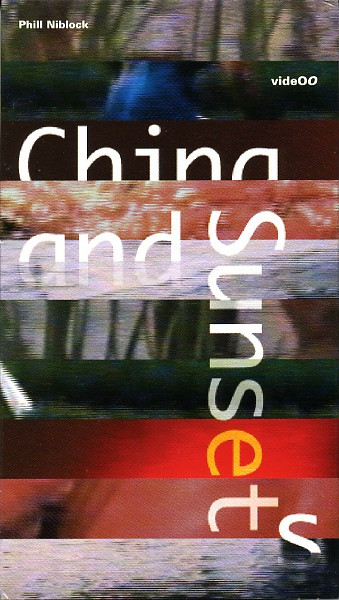
Phill Niblock: China and Sunsets
Phill Niblock (video/music) and various musicians
videOO
VHS video, released 1994
out of print as of this writing
For the past quarter-century, devotees of New York’s avant-garde have relished Phill Niblock’s intermedia performances. Held each year at Winter solstice, these events feature multiple channels of simultaneous video, film and slide projection, with an array of loudspeakers blaring out microtonal drone music accompanied by one or more live musicians moving freely within the loft. Lasting up to eight hours, they are not concerts in the traditional sense, but multimedia environments. The loud music fills the space, the visual information projected in all directions. It’s an engulfing yet strangely relaxing experience.
Phill has now released this videotape for private consumption. Pairing two films with two musical compositions, it spans 23 years of creative work. For home viewing, I suggest you turn up your stereo system and pipe the video to every TV and video monitor you have, walking around in the environment to simulate the encompassing, ambient character of a Niblock performance. Or to maximize the intensity, you could sit in front of a single video monitor in a dark room, and listen through headphones. Alternatively you can listen to the music by itself, which is interesting in its own right.
The first work on the tape is a good introduction to Phill’s audiovisual aesthetic. The music, Early Winter, uses multiple overdubbed channels of acoustic and electronic instruments to “explore the texture of sound resulting from multiple tones in very dense tunings performed in long durations”. The work starts on a E drone in octaves, with neighbor tones entering on either side. As the work progresses, these neighbor tones increase from microtonal intervals to minor and major seconds. Gradually the tonal center shifts to D, with E largely disappearing three minutes before the end.
Phill avoids the usual techniques of musical articulation: melody, counterpoint, meter, etc. Instead he focuses on natural acoustic relationships among individual tones, particularly the beating between closely spaced pitches. His is a minimalist approach to musical space, yet it’s neither the repetitive rhythmic style of Glass or Reich, nor the ambient consonance of LaMonte Young or Terry Riley. This is intense dissonant music, and Phill is perhaps the first minimalist composer to base his technique on dissonance.
China, the accompanying video, is vintage Niblock cinema: 44 unsentimental minutes of manual laborers performing mechanically repetitive tasks. The origins of Phill’s filmic approach date from the 1960s, when he was New York’s most sought-after dance cinematographer. Working extensively with modern dancers, he eventually grew tired of the stylized, self-conscious nature of cultivated "dance". Impelled to look for purer forms of movement, he traveled extensively in the Third World, filming laborers in Peru, Lesotho, Sumatra and Baffin Island, in addition to China. The footage here features agriculture, forestry, basketry, marine and construction workers. Phill’s interest in atomized movement is evident throughout, the action often involving only part of a person’s body. Generally the motion takes place within the frame, the camera moving only to follow the subject.
 Phill refuses to directly exploit any social or literary meaning in his
material, emphasizing the pure, sensual experience of sound and movement.
Yet I find that the loud, severe music adds a tense undercurrent to the
imagery. For me, China conveys a sense of the futility of human
labor. The fields are plowed, the ditches cleared, the roofs repaired. But
the next day brings more soil, more debris, more work. Watching the peasants
on the small screen seems to further diminish their efforts. Their work goes
on with no change or resolution.
Phill refuses to directly exploit any social or literary meaning in his
material, emphasizing the pure, sensual experience of sound and movement.
Yet I find that the loud, severe music adds a tense undercurrent to the
imagery. For me, China conveys a sense of the futility of human
labor. The fields are plowed, the ditches cleared, the roofs repaired. But
the next day brings more soil, more debris, more work. Watching the peasants
on the small screen seems to further diminish their efforts. Their work goes
on with no change or resolution.
After the relentlessness of China/Early Winter, I find Sunsets/First Performance something of a release. In contrast to the large multi-instrument ensemble of Early Winter, First Performance uses eight overdubbed English horns. To compensate for the thinner, monochromatic texture, Phill uses a more complex pitch structure, starting immediately with the dissonant major seventh between F and E, then introducing G as a neighbor tone above F. The English horns are allowed to “breathe”, the space between individual notes in each channel serving as an important pacing device, especially in light of Sunsets’ more timeless imagery. The latter eschews repetitive motion for time-lapse photography of sunlight, water, mountains and clouds. The cutting rhythm is slower than in China. Phill feels that lengthy shots (10 seconds or more) help to diminish one’s sense of editing and juxtaposition. The average shot length in Sunsets is 49 seconds.
Phill’s images generally appear in the order they were shot. There is no rearrangement or manipulation of the footage, no intercutting between takes or superposition of different shots. By avoiding such techniques, Phill shifts the visual emphasis from cinematic montage to a more direct experience of light and motion. Likewise, his avoidance of recognizable musical gestures replaces the traditional concept of musical structure with one based on pure sound surface. Curiously, this formal strictness forces the elements to opposite extremes: the imagery towards the representational, the music towards the abstract. This divergence, coupled with a lack of sync sound or location audio, creates a certain detachment between sound and image. So does the camera style, which frames images objectively, but focuses on the mundane rather than the extraordinary. It is this unique stance towards his materials that best defines Phill’s personal aesthetic.
In a way, Phill Niblock has fallen between the cracks of the art world, never fitting into anyone’s neat musical or cinematic categories. Filmmakers consider him a composer; composers often refer to him as a filmmaker. Others know him for his landscape photos and portraits of jazz musicians. Critics seem to regard his visual works as diminishing his “seriousness” as a composer. Phill is a legitimate intermedia artist, a much hyped, but rarely actualized (for his generation at least) phenomenon. Active as a concert producer and promoter of other artists’ work, he has largely been overlooked in America for his own accomplishments. But as the new media take root, making intermedia art better accepted, perhaps Phill Niblock will finally be appreciated as simply an artist.
- Michael Schell, December 1994
![]()
Selected writings |
Schellsburg home
Jerry Hunt |
cribbage
![]()
Original Material and HTML Coding Copyright © 1994–2016 by
Michael Schell. All Rights Reserved.